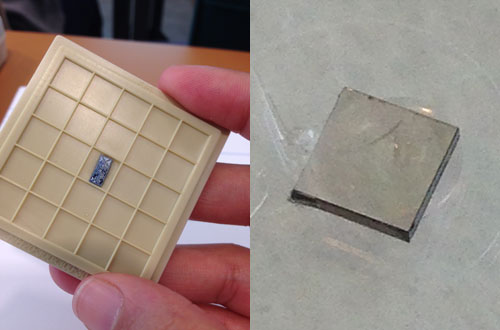
Quantum kit: two superconducting qubits (left) and an artificial diamond with an NV centre (right). (Courtesy: Tushna Commissariat)
By Tushna Commissariat
I’ve left sunny Stockholm and I’m back at the office in blustery Bristol, but I still have a few good quantum tales to tell from the science-writers’ workshop at NORDITA last week. On Thursday, the main speaker of the day was Raymond Laflamme, who is the current director of the Institute for Quantum Computing at the University of Waterloo in Canada. Laflamme – who kick-started his career working on cosmology at the University of Cambridge in the UK as a student of Stephen Hawking – studies quantum decoherence and how to protect quantum systems from it by applying quantum error-correction codes, as well as using nuclear magnetic resonance (NMR) to develop a scalable method of controlling quantum systems.
Laflamme is an enthusiastic proponent of quantum technologies and believes that they are set to transform the world as we know it. “Quantum information technology will change your lives and your children’s lives…but your grandchildren will think its passé!” he exclaimed early on in the day. As someone who has been studying the quantum world for years now, Laflamme is still very humble about what researchers definitively know about the underlying reasons for quantum mechanics. Talking about the double-slit experiment with one photon, he told me that “if you are not surprised by this, then you are way ahead of us”.
Laflamme talked about “harnessing our curiosity” about quantum mechanics to develop technologies that could, according to him, ultimately have a huge impact on society. In light of this, he highlighted some pretty amazing quantum-information spin-offs. This was surprising in many ways because the actual quantum technology – a quantum computer – is nowhere close to being fully realized. But while researchers are developing the computing technology, there are already some ideas for practical applications from the early work in the field that adopt the basic principles of entanglement and superposition.
One such technology would be using the variety of qubits that researchers make – including trapped ions, superconducting qubits, trapped atoms and nitrogen-vacancy centres in diamond – as different types of “quantum sensors”. These sensors, according to Laflamme, would offer excellent efficiency, precision, sensitivity and robustness. The really interesting thing about such sensors is that they would turn a so-called bug in quantum systems – that is, the sensitivity of superposition to the environment that leads a system to decohere – and turns it into a feature. Indeed, a story that I wrote last month describes how researchers are using quantum information techniques, including quantum error correction, to measure the minuscule magnetic interactions of two electrons – a tiny signal in a very noisy system. These quantum sensors would also be very versatile, easily tunable and relatively easy to scale, according to Laflamme.
A more practical application Laflamme talked about involves oil exploration. Error-correction codes that were developed for liquid-state NMR quantum computing are helping to develop more robust sensors for the oil industry. NMR is used to check for the relative amounts of oil and water in a potential oil well and even study the porosity of the rock surrounding a deposit. The error-correction codes are useful to the oil-exploration companies to help them avoid the inhomogeneities that crop up when processing information, thereby making the drilling process that much more accurate.
Laflamme also brought along some quantum paraphernalia that most of us in the room had never seen, let alone handled, including two superconducting qubits and an artificial diamond with a nitrogen-vacancy centre (see image above).
“We are no longer in the basement of developing practical quantum technologies…we are on the first floor, but it’s a long way up,” said Laflamme, and he may just be right.
Guidelines
Show/hide formatting guidelines
this text was deletedwhere people live in harmony with nature and animals</q>
Some text